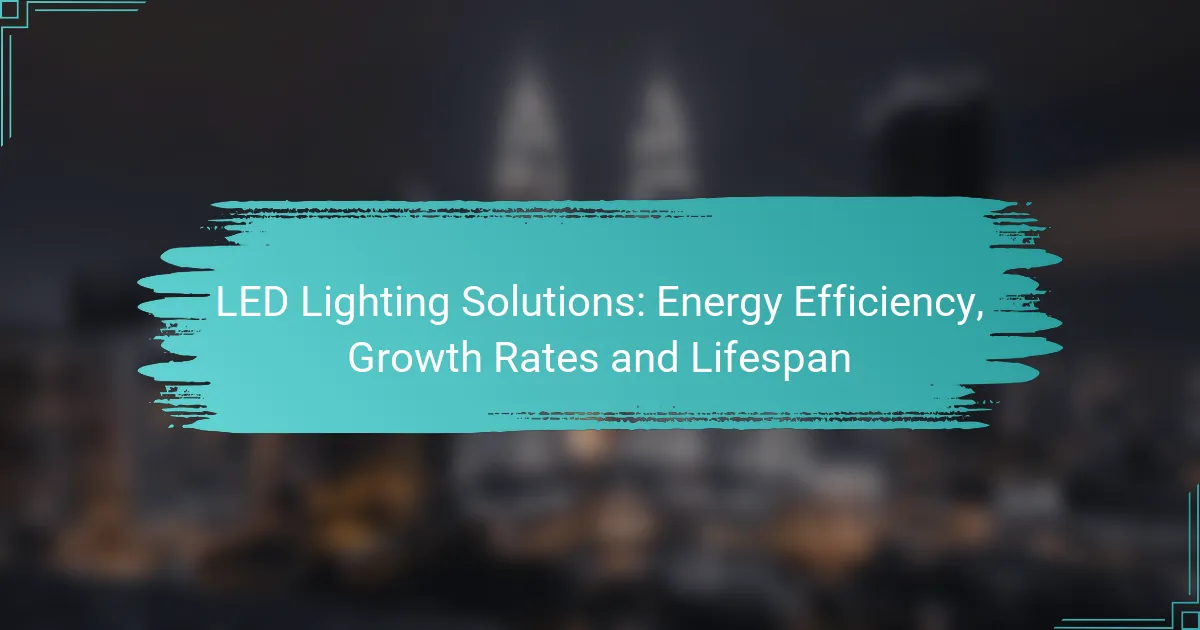LED lighting solutions are revolutionizing the way we illuminate our spaces by offering remarkable energy efficiency and longevity compared to traditional lighting options. With their ability to convert a higher percentage of energy into light, LEDs not only reduce electricity costs but also contribute positively to the environment. As the demand for energy-efficient technologies grows, the LED market is poised for significant expansion, driven by ongoing advancements and increasing consumer awareness.
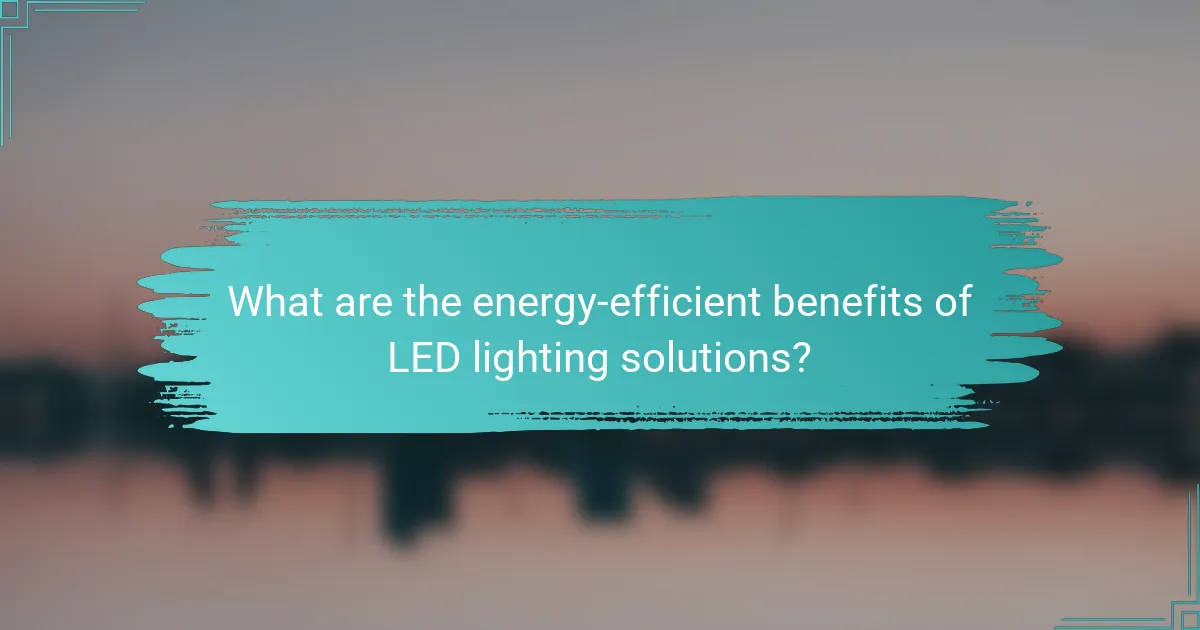
What are the energy-efficient benefits of LED lighting solutions?
LED lighting solutions offer significant energy-efficient benefits, primarily through reduced energy consumption, lower electricity costs, and a positive environmental impact. By utilizing advanced technology, LEDs convert a higher percentage of energy into light, making them a superior choice for both residential and commercial applications.
Reduced energy consumption
LED lights consume considerably less energy compared to traditional incandescent and fluorescent bulbs. Typically, LEDs use about 75% less energy, which translates to lower wattage requirements for the same light output. For instance, a standard LED bulb may only require 10 watts to produce the same brightness as a 60-watt incandescent bulb.
This reduction in energy consumption not only benefits individual users but also contributes to decreased demand on power grids, especially during peak usage times. Switching to LED lighting can be a straightforward way to enhance energy efficiency in homes and businesses alike.
Lower electricity bills
By consuming less energy, LED lighting solutions can lead to significantly lower electricity bills. Users can expect savings of up to 50-80% on their lighting costs, depending on usage patterns and the types of bulbs replaced. For example, if a household spends around $100 monthly on lighting, switching to LEDs could reduce that cost to as low as $20-$50.
Additionally, many utility companies offer rebates or incentives for switching to energy-efficient lighting, further reducing the initial investment costs. This makes LEDs not only an environmentally friendly choice but also a financially savvy one.
Environmental impact
LED lighting has a positive environmental impact due to its lower energy consumption and longer lifespan. By using less electricity, LEDs contribute to a reduction in greenhouse gas emissions from power plants. This is particularly important in regions where fossil fuels are the primary energy source.
Moreover, LEDs have a lifespan of approximately 15,000 to 50,000 hours, which means they need to be replaced less frequently than traditional bulbs. This longevity reduces waste and the environmental burden associated with manufacturing, transporting, and disposing of lighting products. Transitioning to LED lighting is a proactive step toward sustainability and energy conservation.
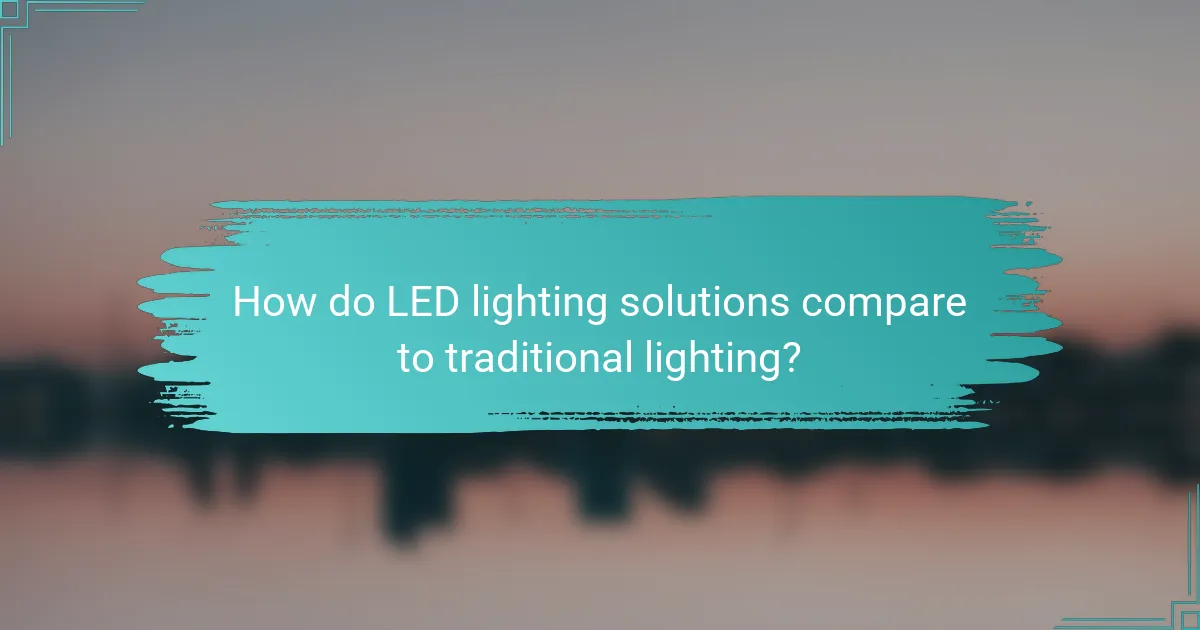
How do LED lighting solutions compare to traditional lighting?
LED lighting solutions are significantly more energy-efficient and longer-lasting than traditional lighting options like incandescent or fluorescent bulbs. They consume less power, provide better brightness, and generate less heat, making them a superior choice for both residential and commercial applications.
Longer lifespan
LED lights typically last between 15,000 to 50,000 hours, far exceeding the lifespan of traditional bulbs, which often last only 1,000 to 2,000 hours. This extended lifespan reduces the frequency of replacements, leading to lower maintenance costs and less waste.
When selecting LED lighting, consider the rated lifespan provided by manufacturers. Choosing high-quality products can ensure you maximize this benefit, as cheaper options may not deliver the expected longevity.
Higher brightness levels
LEDs provide higher brightness levels measured in lumens per watt, making them more efficient at converting electricity into light. While traditional bulbs may require higher wattage to achieve similar brightness, LEDs can produce the same or greater illumination with significantly lower energy consumption.
For example, a typical 10-watt LED can produce the same brightness as a 60-watt incandescent bulb. This efficiency not only saves energy but also reduces electricity bills over time.
Lower heat emission
LED lighting solutions emit very little heat compared to traditional lighting, which can lose a significant portion of energy as heat. This lower heat emission makes LEDs safer to use and reduces the need for additional cooling in indoor environments.
In practical terms, using LED lights can lead to a more comfortable living or working space, especially in warmer climates. Additionally, lower heat output can prolong the life of fixtures and reduce cooling costs, further enhancing energy savings.
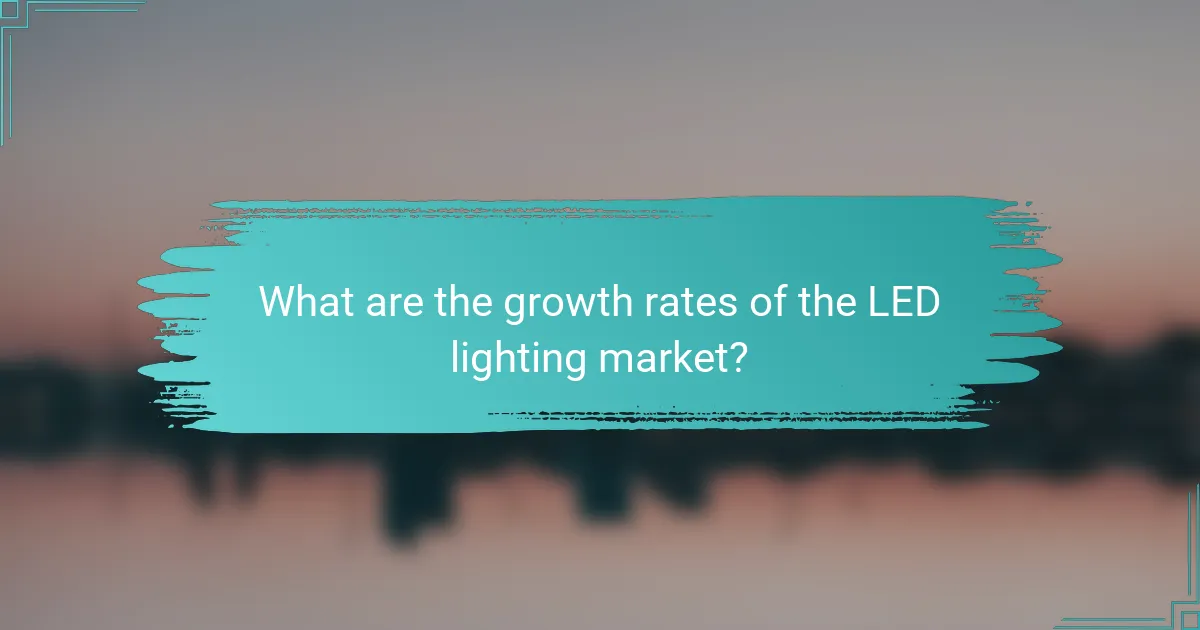
What are the growth rates of the LED lighting market?
The LED lighting market is experiencing rapid growth, driven by increasing energy efficiency demands and technological advancements. Market analysts project that the sector will continue to expand significantly over the coming years, with various regions contributing to this upward trend.
Market growth statistics
The global LED lighting market has been growing at a compound annual growth rate (CAGR) of approximately 10-15% in recent years. This growth is fueled by the transition from traditional lighting solutions to energy-efficient LED alternatives, which offer longer lifespans and lower energy consumption.
In monetary terms, the market size is expected to reach several billion USD by the mid-2020s, reflecting a robust demand across residential, commercial, and industrial sectors. The adoption of smart lighting technologies is also enhancing market dynamics.
Regional growth trends
North America and Europe are currently leading the LED lighting market, driven by stringent energy regulations and a strong push for sustainability. In these regions, the adoption rate of LED lighting in both residential and commercial applications is high, often exceeding 50% in new installations.
Meanwhile, Asia-Pacific is emerging as a significant growth area, with countries like China and India rapidly increasing their LED adoption rates due to urbanization and government initiatives promoting energy efficiency. This region is expected to witness the highest growth rates in the coming years.
Future projections
Looking ahead, the LED lighting market is projected to maintain a strong growth trajectory, with estimates suggesting a CAGR of around 12-18% over the next five years. Factors such as advancements in smart lighting technology and increasing awareness of energy conservation will likely drive this growth.
Additionally, as more countries implement regulations aimed at reducing carbon footprints, the demand for LED lighting solutions is expected to rise. Companies that innovate and adapt to these trends will be well-positioned to capitalize on the expanding market opportunities.
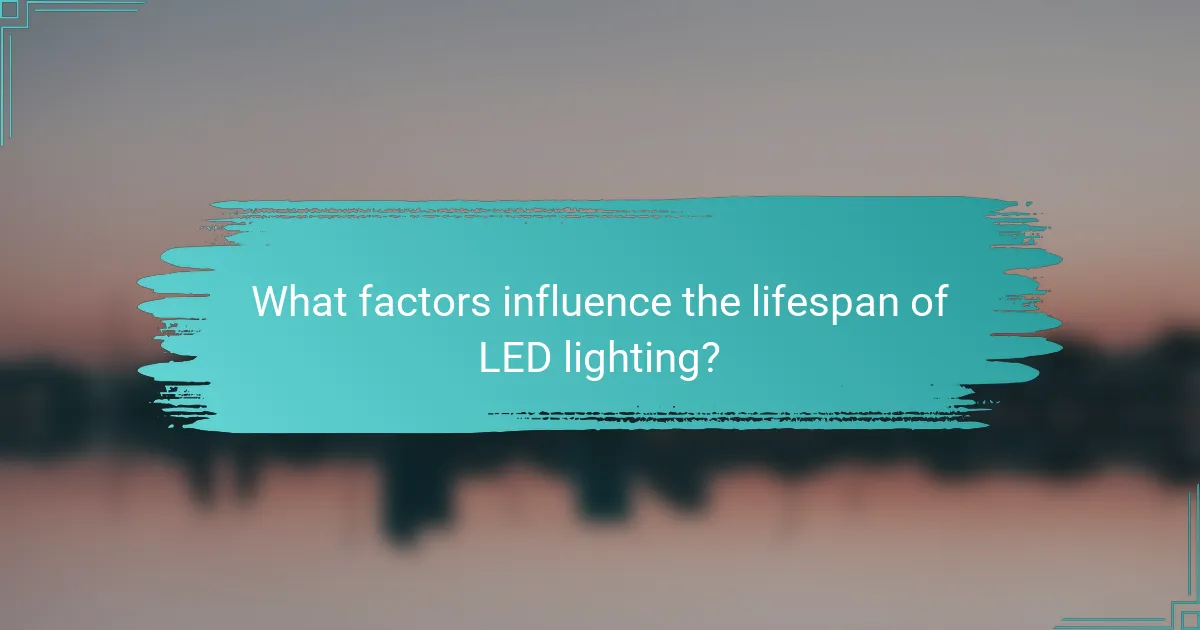
What factors influence the lifespan of LED lighting?
The lifespan of LED lighting is primarily influenced by the quality of components, usage conditions, and installation practices. Understanding these factors can help maximize the longevity and efficiency of LED fixtures.
Quality of components
The quality of components used in LED lighting significantly affects its lifespan. High-quality LEDs, drivers, and heat sinks can extend the operational life, often exceeding 25,000 hours, while lower-quality components may lead to premature failure. When selecting LED products, look for reputable brands that comply with industry standards.
Additionally, consider the materials used in the construction of the fixture. For instance, aluminum heat sinks are generally more effective than plastic ones in dissipating heat, which is crucial for maintaining performance over time.
Usage conditions
Usage conditions play a vital role in determining how long LED lights will last. Factors such as temperature, humidity, and exposure to contaminants can impact performance. LEDs typically perform best in moderate temperatures, ideally between 20°C and 30°C (68°F to 86°F).
Moreover, environments with high humidity or dust may require additional protective measures, such as sealed fixtures, to prevent moisture and debris from affecting the components. Regular maintenance can help ensure optimal performance in challenging conditions.
Installation practices
Proper installation practices are essential for maximizing the lifespan of LED lighting. Incorrect wiring, inadequate ventilation, or improper mounting can lead to overheating and reduced efficiency. Always follow manufacturer guidelines during installation to ensure that the fixtures operate as intended.
It’s also advisable to use compatible dimmers and controls, as mismatched devices can strain the LED driver and shorten its life. Regular inspections can help identify potential issues early, allowing for timely corrections that can prolong the lifespan of the lighting system.
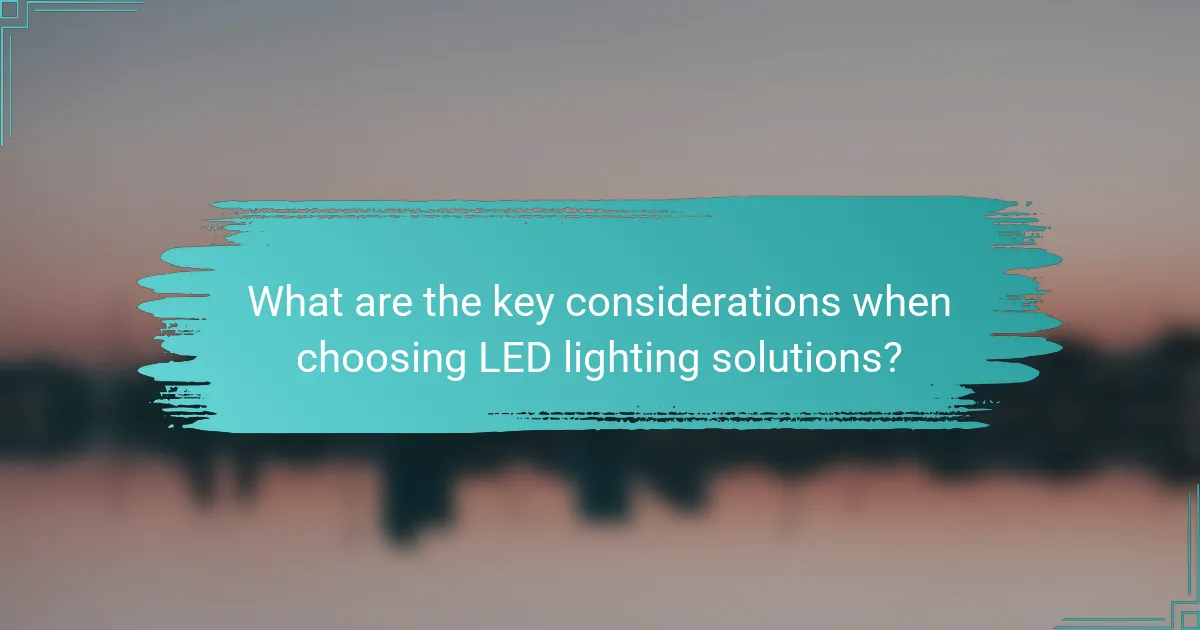
What are the key considerations when choosing LED lighting solutions?
When selecting LED lighting solutions, consider factors such as brightness, color temperature, and energy efficiency ratings. These elements significantly impact the performance, ambiance, and cost-effectiveness of your lighting system.
Brightness and color temperature
Brightness is measured in lumens, and the required level depends on the space and its intended use. For example, a living room may need around 1,500 to 3,000 lumens, while a workspace might require 3,000 to 5,000 lumens for optimal visibility.
Color temperature, measured in Kelvin (K), affects the mood of a space. Warmer tones (2700K-3000K) create a cozy atmosphere, suitable for homes, while cooler tones (4000K-5000K) are ideal for offices and task-oriented areas. Choose a color temperature that aligns with the intended function of the room.
Energy efficiency ratings
Energy efficiency ratings indicate how much light is produced per watt of electricity consumed, typically expressed as lumens per watt (lm/W). High-quality LED lights can achieve efficiencies of 80 lm/W or more, significantly reducing energy costs compared to traditional incandescent bulbs.
When selecting LED products, look for certifications such as ENERGY STAR, which ensures compliance with strict energy efficiency standards. This not only helps in reducing electricity bills but also contributes to a lower carbon footprint, making it a sustainable choice for both residential and commercial applications.
